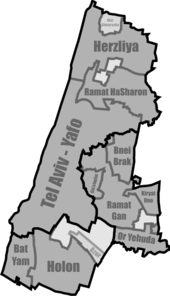Tel Aviv District
The Tel Aviv District (Hebrew: מָחוֹז תֵּל אָבִיב;) is the smallest and most densely populated of six administrative districts of Israel with a population of 1.35 million residents.[2] It is 98.9% Jewish and 1.10% Arab (0.7% Muslim, 0.4% Christian).
Tel Aviv District | |
|---|---|
| - transcription(s) | |
| • Hebrew | מָחוֹז תֵּל אָבִיב |
 | |
| Cities | 10 |
| Local Councils | 2 |
| Regional Councils | 0 |
| Capital | Tel Aviv |
| Government | |
| • Appointee | Carmit Fenton |
| Area | |
| • Total | 186 km2 (72 sq mi) |
| Population (2016) | |
| • Total | 1,388,400 |
| ISO 3166 code | IL-TA |
The district's capital is Tel Aviv, one of the two largest cities in Israel and the country's economic, business and technological capital. The metropolitan area created by the Tel Aviv district and its neighboring cities is locally named Gush Dan.
It is the only one of the six districts not to border either the occupied West Bank or an international border, being surrounded on the north, east, and south by the Central District and on the west by the Mediterranean Sea. The population density of Tel Aviv district is 7,259/km2.

Administrative sub-regions
| Cities | Local Councils |
|---|---|
|

List of cities and towns in Tel Aviv district
| Pop Rank | Name | Population | Land Area (Dunams) | Founded | City Since |
|---|---|---|---|---|---|
| 1 | Tel Aviv-Yafo | 438,818 | 51,788 | 1909 | 1921 |
| 2 | Holon | 190,838 | 18,927 | 1940 | 1950 |
| 3 | Bnei Brak | 188,964 | 7,343 | 1924 | 1950 |
| 4 | Ramat Gan | 153,674 | 13,229 | 1921 | 1950 |
| 5 | Bat Yam | 129,100 | 8,167 | 1926 | 1958 |
| 6 | Herzliya | 93,116 | 21,850 | 1924 | 1960 |
| 7 | Giv'atayim | 58,509 | 3,246 | 1922 | 1959 |
| 8 | Ramat HaSharon | 45,066 | 16,792 | 1923 | 2002 |
| 10 | Kiryat Ono | 38,596 | 4,112 | 1939 | 1992 |
| 9 | Or Yehuda | 36,536 | 5,141 | 1949 | 1988 |
| 11 | Azor | 12,570 | 2,415 | 1948 | |
| 12 | Kfar Shmaryahu | 1,911 | 2,665 | 1937 | |
| 13 | Glil Yam (Hof HaSharon RC) | 500 | - | 1943 | |
| 14 | Mikveh Israel | 432 | 3,300 | 1870 |